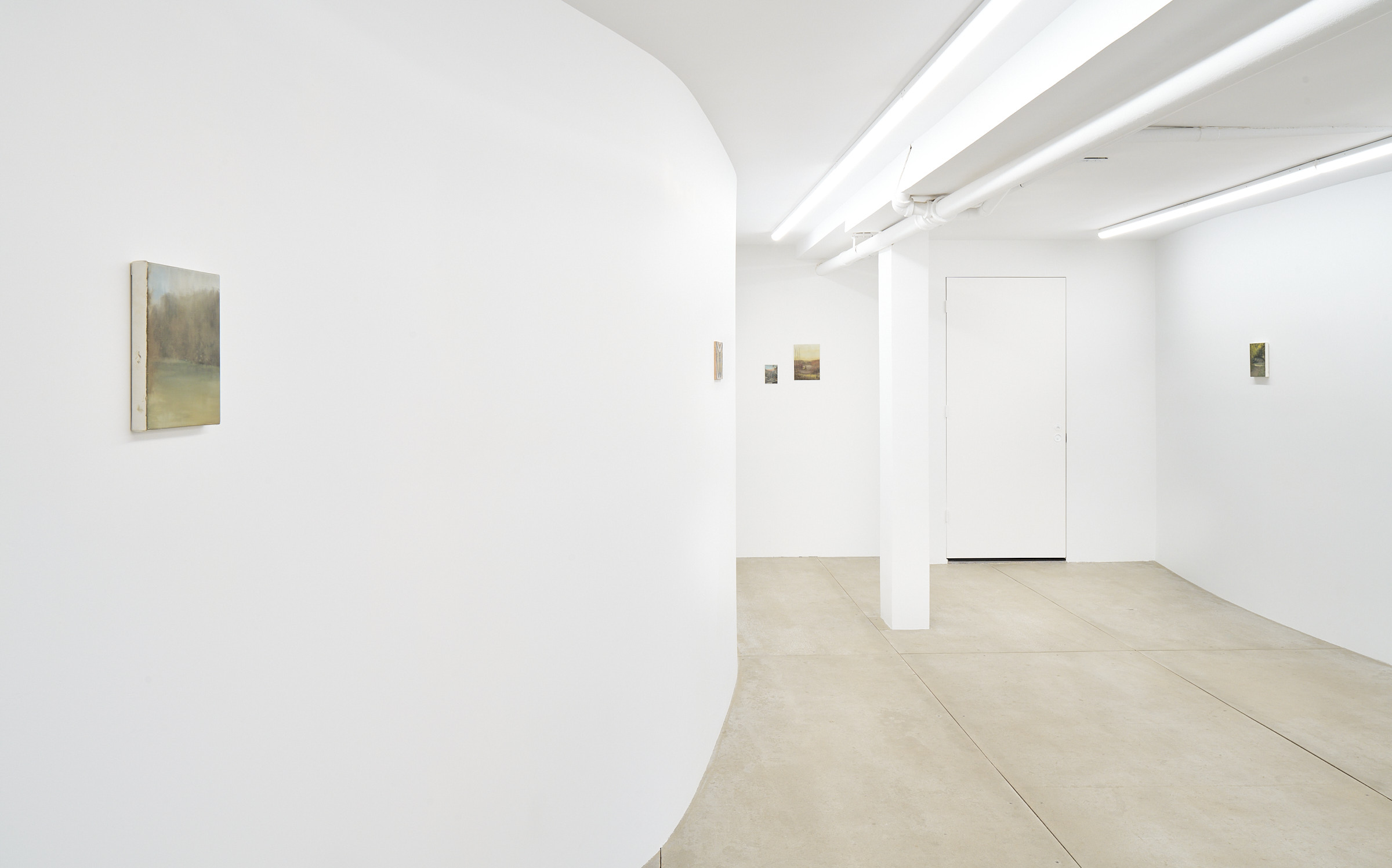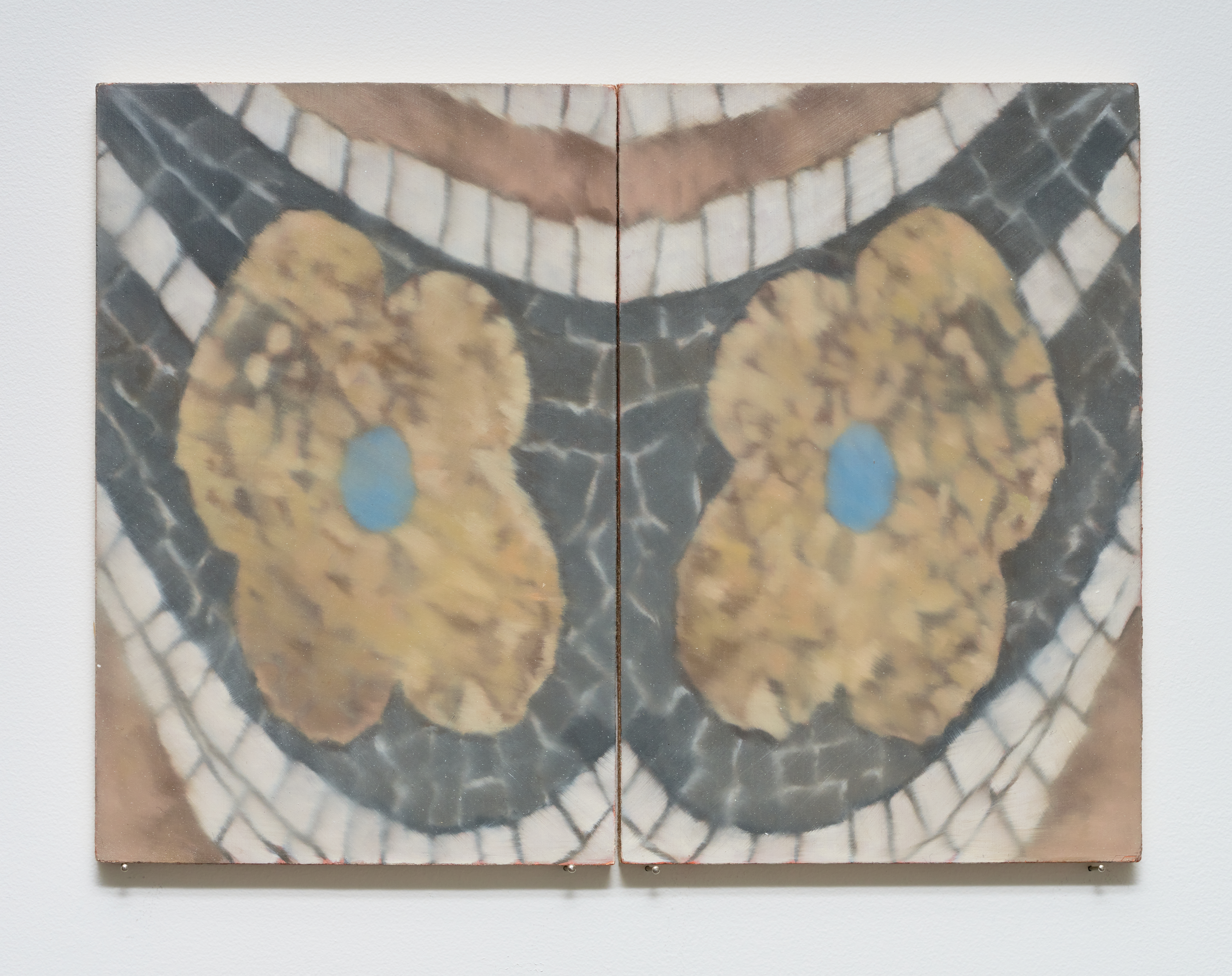Kate Wallace on the curve that warms showing at LEILA GREICHE

Installation view of the curve that warms at Leila Greiche, New York.
Occupying the curved walls of LEILA GREICHE, the new works of Melbourne-based artist Kate Wallace take viewers to a place of stillness and memory. Featuring 11 small-scale paintings that reflect on memory, intimacy, space, the distant past, and isolation, the new body of work in "the curve that warms" takes viewers on a journey through passageways from personal spaces the artist endured.
Wallace's use of iPhone photography and memory to capture scenes of places she has lived or passed through has become one of her most beautifully executed works on painting, most of which are on wood board or linen. Ethereal and nostalgic, with a soft color palette that evokes a sense of warmth, the works leave viewers feeling like they've been in such a space that lives somewhere in their memory bank. Curated with integrity and pull, this is the artist's first solo show in the US.
In "A curve that warms," Wallace depicts a scene across a lake with a subdued color palette and sparse composition, evoking the fragility of one's surroundings. The petite painting offers a moment to embrace warmth, specifically within curvilinear spaces, as she recalls from a passage of Gaston Bachelard's "The Poetics of Space," which provides scenes of comfort and familiarity in which we experience and occupy its warmth through poetic means.
One of the most striking pieces in the exhibition is Standing in a room (2023), which showcases the home's power as a protective space. The painting is initially empty, but as the viewer's eyes adjust, a figure appears standing by the window. This figure then turns to marble, a relic from the past that symbolizes the safety and security of the home. The painting is a reminder that, despite the chaos of the outside world, the home can be a sanctuary from it all.
Another standout piece is A mirror on a wall (2023), which explores the theme of reflection and ambiguity. The painting features only a few objects – a table, a mirror, and a tiled floor – but Wallace creates a sense of mystery and intrigue through careful composition. Viewers are left to ponder whether they are looking at an entry to another room, a portal to a distant place, or merely a reflection of oneself.
Kate Wallace is also showing at Melbourne Now at the National Gallery of Victoria, presenting three paintings that were first exhibited as part of my exhibition 'Memory of Place' at LON Gallery last year.
She talks to Art Currently about the curve that warms, which runs through April 1, 2023.

Flower #1 & Flower #2, 2023, Oil on board
15cm x 10cm (5.9”H x 3.9”W)
1.Could you recall the first time you came across Gaston Bachelard's "The Poetics of Space" and how that informed this body of work?
I was first introduced to Bachelard's text while completing my masters at VCA. I strongly resonated with Bachelard’s descriptions of the home as a site of refuge, a reprieve if you will from the outside world. There is an incredible escapist quality to the way in which Bachelard writes, referring to corners as spaces to day dream and windows as portals to alternate realities. When approaching this body of work, I was drawn to aspects of this text again, especially when engaging with scenes intimate and familiar in nature. The Chapter titled Corners particularly resonated when thinking about scenes of comfort and familiarity, how a corner can provide warmth and shelter during times of unease or stress. Presented within the warmth of the gallery’s curvilinear walls, the paintings explore ideas relating to loss; a longing or desire to return to something past or familiar. These ideas in many ways relate to Bachelard’s analysis of one’s home as a child, acting as a memory to return to when in search of comfort.
2. Your paintings are renditions of photos you took - do you add elements that aren't captured in the picture based on personal memory?
Rather than adding, I view it more as a process of taking something away from the original photographic reference. This process of reduction I suppose echoes the way in which we remember, how memories fracture and distort over time. Through the removal of certain details, be it a door, a figure or a tree, I look to explore ideas relating to memory, place and absence. As will be touched on, techniques such as blurring and glazing are often used in a similar way to obscure certain aspects of the painted image. It is this process of choosing what the viewer can and can’t see that I love about painting.
What is your process like when blurring and using such techniques to invite viewers to a memory or moment in time? The paintings to me felt familiar - as if somewhere in my memory bank - a similar experience of space as a refuge.
Throughout the painting process, techniques such as blurring, detail (or lack there of) are employed as a means to relay some semblance of place, of a space once lived or passed through. A fragmentary view into something past. This process can be quite intuitive and is often guided by the painting; what is required in order to illicit a sense of the familiar or describe a memory. The use of blurring and other techniques such as glazing are drawn upon to obfuscate and limit what the viewer can and cannot see, which in many ways reflects the frailty of how and what we remember.
Some paintings are built up over time, requiring several layers until there is a type of cohesion across the painting surface. Others are completed in a single layer in what, by comparison, is an often 'looser' painting style, in turn reflecting the fragile and transitory nature of memory. Painting I think is akin to language in its ability to describe and depict, therefore different techniques are required when approaching different subjects or places.
3. How has space influenced you as an artist throughout your career? Has your interpretation of space changed over the years?
I’ve always been drawn to familiar places, be they spaces lived or passed through. The idea of space as a source of comfort or refuge is something I’ve always found interesting, as is the idea that such spaces can also serve as sites of unease and chaos. I find this duality in meaning, that a place can offer alternate narratives paramount to relaying ideas relating to change and the shifting nature of remembering. In this sense my interpretation of space through paint has manifested in different ways throughout the years.

